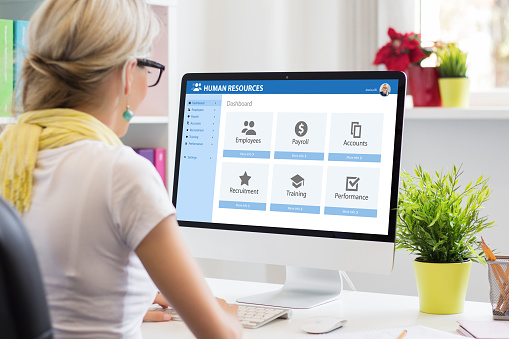An HRMS, also known as a human resource management system is a collection of software programs designed to manage human resources and associated processes throughout the lifecycle of employees. An HRMS allows a business to be aware of its workforce and be in compliance with ever-changing legislation on labour and tax law.
HR managers and employees are the main users because they oversee daily operations for the workforce and are in charge of the compliance and reporting of performance. But HR isn’t the only department that can benefit from HR technology. Employers can provide employees and managers with self-service to perform common tasks, which is a major attraction for new hires. Executives can utilize an HRMS to gather statistics on the trends in the workforce, and their implications for business.
As HR-related expenses are among the most significant costs incurred by companies, HRMS integration with the accounting system is a boon for finance departments. Leading companies will go beyond the basics of accounting to assist businesses get better insight into the financials of HR information.
HRIS vs HRMS
It is possible to hear the word “HRIS,” an acronym for human resource information system that is often used to refer to HRMS. The origins of this term go back from the 1980s in the time in the time when IT departments were identified as management information systems (MIS) department. As HR information and processes were computerized, a variation of MIS, called HRRIS, was created.
The primary HRIS purpose was the electronic management and recording of records for employees. This is why HRIS is an term used by HR professionals to refer to the time when human resource processes, records and reports are converted to electronic format through the application of software.
As technology advanced and the system grew beyond the simple task of keeping records of employees, HRIS became known as HRMS. Nowadays, HRMS and HRIS remain used in the same sense for the systems that keep employee information and automate HR processes within the workplace.
History of HRMS(Human resources management system)

In the 1970s, when companies sought to automatize the management of their employees Payroll became the first HRMS feature to be computerized. However, it required the mainframe to compute an employee’s earnings, calculate withhold deductions and print checks on paper and keep track of the liabilities of payroll. It wasn’t until the beginning of the 2000s, when there was increasing adoption of direct deposit and employee self-service that payroll processes was completely electronic.
PeopleSoft was one of the first companies to develop an all-encompassing HRMS software in the latter half of the 1980s. Along with payroll, it also offered the management of employee records, recruitment time and attendance benefits administration as well as compensation and compliance reporting and many other features that helped HR professionals to automate more of the employee’s cycle and take better decisions about their workforce.
The advent online in latter part of 1990 provided the benefits of automation to a variety of HR processes. For instance the paper-based ads for help-wanted were replaced with electronic job boards, which gave applicants and recruiters new avenues to connect. By the time the 2010s arrived cloud technology was widely used. Today HR departments of all sizes enterprises could afford to use a variety of software without spending expensive IT hardware or staff to run and manage the systems.
What’s next?
2020 and beyond promise greater HRMS advancement. Predictive analytics and machine learning are integrated into the majority of modern systems. However, the advancement of artificial intelligence can help businesses predict future requirements for skills recognize trends in the workforce, and match the best-suited candidates to jobs that are open.
The importance of HRMS(Human resources management system)

The cost of HR, specifically the cost of office spaces, is changing in the present, with shifts towards a home-based work model, businesses still need to be able to accurately estimate labor costs in order to ensure that revenue per employee KPIs up to date. Joseph Hadzima, a senior lecturer at the MIT Sloane School of Management estimates that base pay together with benefits and taxes generally amount around 1.25 up to 1.4 times the annual salary. Therefore, a $50,000 year worker could actually cost anywhere from $62,500 to $70,000 not including real estate or technology, like computers and phones.
Additionally, businesses with stretched human resources departments should consider implementing self-service options. There’s no reason why HR specialists to spend time helping a manager by providing regular updates on hours worked, like or helping employees use forms such as W-2s.
Fortunately, accurate financial information reporting and safe self-service are only two advantages of a modern HRMS.
Functions of an HRMS
If you are deciding the HRMS is best for your business It is helpful to think of it in terms of functional elements. The most modern HRMS encompass seven different areas, with different levels of attention.
Candidates management: It relates to job offers to applicants and how you present your company’s image to the world outside and your current employees who might wish to apply to internal jobs or provide recommendations. Important for companies where the experience of candidates is the primary goal – from applying , resume management, the scheduling of interviews to offering offers from onboarding to interview scheduling.
Engagement in the workplace: Employees who are engaged tend to create better quality work and are more able to embrace the values of the business and follow its mission, therefore how employees interact with their colleagues and leadership is crucial. In many cases it is said that the HRMS is the best way to finish a course of training or learn the latest skill, create a career path, get recognition, or become mentors.
Management of employees This job is sometimes called “core HR.” It provides an central platform to facilitate analysis procedures, reporting and compliance. It’s where you organize your workforce into units of organization such as departments or locations and establish reporting relationships between employees and managers; and connect payroll to the accounting costs centers. Personal information is stored and kept This is at the heart of your initiatives to provide employees self-service, increase reports and enhance the quality of HR services.
Optimization: Using data of the HRMS(Human resources management system) to formulate a plan of the future workforce is the primary reason for selling. It’s also one of the least utilized functions of the common HRMS. The true benefit of this feature usually occurs during the merger or acquisition of a company and sharp economic shifts either way, or when top executives leave. Businesses that adopt an active approach to improving their workforce can be more resistant to changes and are more likely to retain top talent, and higher employee engagement.
Payroll is an essential function of the HRMS – calculating the earnings from net to gross and net-to-gross, and making individual deductions, and issuing payouts can be as easily as paying rent. Payroll functions include benefit selections as well as employer and employee expenses. Full-service payroll solutions can also automate tax filings and deposits. Self-service features allow employees to make modifications to deductions that they elect Direct deposit accounts, direct deposit accounts and tax withholdings as well as get copies of earnings statements without the assistance of HR.
Workforce management HR teams monitor employee development management evaluations, manager evaluations, and disciplinary action; track the time and attendance of employees and ensure that the organization offers the best possible safety and health workplace. It is also where the compensation planning and management of performance, as well as learning and incident tracking functions reside. HR can design timesheet structure as well as regulations for overtime, time off policy and approval chains in a way that increases efficiency, control, and automation. The process for reviewing employee performance along with goal-setting is built into this area as well.
Management of contingent workforces: In line with primary management of the workforce and essential for businesses that do not have every employee full-time. Interns, contractors, consultants and temporary workers provide specialization, assist local community initiatives, or university programs , and can handle the increases in demand for labour. The HRMS is not able to manage all these relationships since they do not necessarily belong employed and typically not covered by benefits, However, the work they perform helps to ensure the success of the business and it is important to keep track of the number of contingent employees in the company at any given point and the overall cost.
When you’ve got a good knowledge of the functions that are the most crucial then it’s time to look into specific functions.
HRMS Features(Human resources management system)

With their broad capabilities, HRMS feature sets can differ widely from one provider to the next provider, and the combination of different products could restrict the overall system. Finance, HR, IT and other key stakeholders must carefully examine which features in the HRMS are crucial to the business.
Benefits administration: HR professionals can help create plans, set eligibility rules and process payments or deposits to benefit providers. Additionally, they offer self-service open enrollment, and integrates benefit costs into accounting.
centralized records for employees. Offers one repository where every employee’s record is kept up-to-date and maintained. This allows for more efficient reporting and reduces the cost of compliance and getting ready for audits.
Learn management tools are designed to aid employees to learn or improve their capabilities through course administration as well as course and curriculum development tests and certifications. It also allows businesses to provide and track the compliance training required by law.
Analytics and reporting: Provides the capability of running operational reports that track HR data, compile compliance reporting, and create Key Performance Indicators (KPIs) to assess HR processes’ performance, and incorporate the HR performance metrics in financial dashboards to aid in business-wide analysis, planning, and making decisions. Additionally, look out for the capability to develop ad-hoc report reports.
Rewards: Calculate salary and hourly wage, as well as variable bonuses and sales commissions, overtime, shift differentials , and merit increases as well as withholding regulatory and elective deductions, which results in precise net payment to employees on a regular basis. Benefits, such as match retirement fund contributions, as well as mobile phone credits are often included in this set of features.
Recruitment of talent: Recruiters can create career pages for the intranet and company’s website creating job requisitions, descriptions, manage jobs and integrate open positions into job boards and resumes, monitor applicants through the recruitment process make job offer extensions, conduct background checks, perform pre-employment screenings and develop applications for jobs, prior to sending new employees to a generalist, or the hiring manager to start onboarding.
Talent management: Allows HR professionals to create and assess employees through goals management, performance reviews and competency and skill testing administration.
The system can be used to track attendance and times. Offers the capability of processing time-off requests, and manage balances of time-off employees’ managing absence and scheduling. It also lets timecards be integrated into payroll and project.
User interface: Since HRMS systems can be accessible to everyone in the workforce an easy-to-use interface is essential. Modern systems provide self-service for managers and employees mobile apps, localization, personal dashboards workflow automation, notifications and access control based on role to keep employees engaged , and inquiries to the department of IT or HR to the minimum.
Workforce planning: Offers the capability to budget and plan the costs of a workforce and compare them to actual expenditures for both future and present scenarios. Also, it can be used to assess skills gaps, develop succession plans, and prioritize recruiting efforts.
Additional features can be found in HRMSs that are specialized but not every company requires a fully-loaded system. If you choose to use several providers for your HRMS, be sure all systems have an open architecture that allows bi-directional data exchange as well as necessary integrations and uploads to the system. Utilizing a single provider to form an HRMS eliminates the need for one-off integrations. These are costly, complex and difficult to update and secure.
So far, we’ve covered about features and functions. However, those who must convince management the HRMS’s benefits are an excellent purchase should be prepared for a more detailed business ROI discussions.
Benefits of an HRMS(Human resources management system)

The primary benefit for an HRMS is the ability to store all the information about your workforce stored in one central location. This reduces the risk of compliance, gives you a wealth of data that can aid in making decisions, aids in keeping employees happy and also makes HR professionals more productive and process more effective.
Let’s take a look at the top five benefits of an HRMS.
More accurate, more detailed insight If you don’t have an HRMS, employees and managers accumulate data in multiple places, from spreadsheets expense apps and papers and paper records, making it difficult to have a comprehensive overview of the costs associated with workforce. When you have an HRMS in place, every information is stored in one place with greater accuracy. That enables better, faster decision-making. It’s also essential to the workforce planning and analytics initiative, in which a business examines its workforce’s current situation and then compares it to the needs of the future as determined by the business goals. The main benefits of this are the ability to detect and fix skills gaps before they impact productivity, establish succession plans and get in control of costs for labor by understanding how overtime or double time payments impact the financial performance.
Through the aid of an HRMS system, HR departments can detect early signs of issues. For instance, if highly-performing employees leave one department at a greater rate than normal it could be a sign of an untrustworthy manager. A HRMS can help connect dots and assist in identifying at-risk employees.
Employee engagement is improved A HRMS(Human resources management system) can be a huge help in attracting and keeping talent, something HR managers are committed to. In within an HRMS, HR can create programs for training, tailor career plans and learning plans and establish mentorships.
In reality, Harvard Business Review suggests that the development of skills is vital to employees who are younger and suggests a mentorship program that focuses on sharing knowledge. Gen Z and Millennial workers are also expected to be asked frequently regarding their experiences. A HRMS can help connect senior employees in the same department or geographical area with people who could benefit from a mentorship relationship that is conducted online, and also provide and report on employee satisfaction and satisfaction surveys.
Each of these activities is monitored in the HRMS to track developmental milestones. This helps employees stay in line and loyal to the company.
Process efficiency and the culture of self-service responding to queries or managing major programs, such as benefit enrollment or performance evaluations which can consume up 40 percent of the time an HR professional spends every week. In many instances, employees would be more than content to handle the work for themselves. In HRMS, within HRMS, HR can set up a knowledge base so that individuals can locate the answers they need to commonly asked questions and employees and managers are able to safely access their personal records which allows HR to concentrate on more efficient services that add value.
Furthermore process approvals for HR that are multiple, such as processing job requisitions, timecards and requests for time-off, could be time-consuming. A HRMS has approval workflows that are capable of automating these processes and others to notify approvers when it’s their turn accept (or refuse). The process can be reduced by 50% and increase accuracy.
Lower back-end overhead: From an IT and capital-spending POV, the centralized nature of an HRMS–especially one sold in a fully cloud-based, software-as-a-service model–requires less hardware, data center space and IT and development staff resources for maintenance, support and training. This reduces the cost of IT to support HR technology, requires the use of fewer help desk employees and, in general, improves the satisfaction of the full-time users of an HRMS and the HR department itself.
Speedier recruitment attracting top talent and developing your reputation as “the one where everyone wants do business” is another subject HR professionals are enthusiastic about. The experience of the candidate is however neglected because it is difficult to get a clear picture of the process of job searching in the event that job advertisements are posted outside the organization. A HRMS helps solve this issue by connecting candidates and recruiters electronically through job boards as well as mobile apps and makes the process comfortable and effective.
HR has access to candidate-pooling technology that speeds up passive recruiting as new jobs become available.
HRMS(Human resources management system) Security

Personal employee data needs a high degree of security to ensure the privacy rights of employees and to comply with obligations, but also to ensure the company’s culture positive. There is no other piece of information could cause tension like an employee finding out the earnings of colleagues in similar roles, with the exception of the possibility of details about personnel actions being made public.
Thus, security features that ensure that employees are not able to access sensitive information should be at high on your HRMS list needs.
Some industries, like finance or health care or multinational firms might require special security standards but all HRMS customers should make sure that:
Access based on role: HR employees need different rights than other employees with good reason. Managers must be able do certain tasks, and specific employees, as well as others that pertain to their personal data. The HRMS must allow for all roles required to oversee your constituents.
System segmentation Systems segmentation HRMS must be setup so that certain data can be accessed only to specific individuals or positions. Even within HR departments Certain companies have implemented security protocols that allow HR professionals access only to certain groups of employees they are serving. In most cases executive payrolls are divided into distinct accounting entities in order to secure this data.
Two-factor authentication. The broad use by mobile phone makes it easier to use two-factor authentication to provide an additional level of security.
Security of data: Every employee data must be encrypted when in storage within the HRMS as well as in transit to the final user.
Policies for password strength and reset: IT should be able to specify certain lengths of password and complexity as well as define reset times, frequently as often as every 30 days, in order to stop the unauthorized access of HRMS data.
An approach that is multifaceted to the security of HRMS systems is what that a prospective purchaser, investor, or cybersecurity insurance underwriters will definitely seek out, so make sure to build it right from the beginning.
Choosing an HRMS(Human resources management system)
It is true that the HRMS market is extremely dispersed and it can be overwhelming. Some top review sites for software list more than 700 companies offering HRMS systems for managing human resources. To evaluate all of them at a the rate of two per day can take nearly the entire year.
The initial step would be to divide prospective providers into three categories:
ERP (also known as Enterprise Resource Planning, providers integrate their other business applications, such as accounting, CRM , and procurement which means you can enjoy the advantages of centralization, for instance, having to enter an employee’s record once. With less integration cost, the ERP model can offer a more consistent user experience. You also have a single security model, which is the reason 95% of companies report improvement in their processes after the implementation of an ERP.
The disadvantage of the ERP class is the fact that you don’t necessarily have the variety of options an HRMS specialist can provide, which means you might have to perform certain tasks, such as running payroll by yourself. User interfaces are also less user-friendly, more like an accounting-oriented interface than an actual social media experience that’s designed for consumers.
The top-of-the-line providers are specialized in one or three areas (sometimes even more) of HRMS. They provide more features and less complicated user interfaces. The disadvantage of best-of- the breed is that they typically do not offer a complete HRMS system. There are additional costs when you require integration with other systems like accounting. The system might not expand to meet your needs So, ask for scalability.
Service providers provide an outsourced service, in which companies pay a company to manage payroll and tax filing, manage benefits, ensure that the HR department in compliance and transfer data to accounting to allow HR-related expenses to be included in financial statements. The service provider functions as your HR department, and requires less HR professionals who are employed at the company.
The services offered are with a cost that is higher per month as well as being difficult to quit, and give the user less oversight over your HR processes and HR data and result in more costs for integration.
When to Purchase an HRMS(Human resources management system)
There’s no standard solution to the question of when to start the HRMS project. The most common reasons that prompt businesses to buy or upgrade include the hiring of an HR manager who is new or expanding their business into new States or nations, failing audit or purchase of an accounting system that is new or deal or merger. Other reasons include the introduction of new regulations, reporting demands, rapid growth or the need to plan better for how to handle the coming workforce.
HR Finance, IT and HR executives should be part of the committee that selects HRMS. Once the selections are narrowed down it’s recommended to invite a broad range of employees who will utilize the system to review the features and interface. The employees will then serve as the system’s advocates when it’s launched.
Components of HRMS Success
In the end, here are our five key points to make the most of your HRMS(Human resources management system) purchase:
- If you’re IT philosophy is progressive, look into the possibilities of using machines learning as well as predictive analytics right now and also have a road map towards AI. The earlier you begin feeding the system with data to it, the better it will be able to provide advice on the future needs of your workforce and match applicants to jobs.
- The different HRMSs are excellent in particular areas. Are you experiencing lots of turnover? Consider carefully the managerial capabilities. Do you have a multinational or multi-state workforce? Check that the system is able to manage complicated payroll situations. Do you hire lots of temporary employees but you’re wondering if it would be more efficient to hire? A management of contingent workers can aid in analysis.
- It’s not possible to sell an HRMS to budget holders simply by talking about the cool features. What will get a project funded are the insights into how the system can help keep talent in the system, free HR personnel for value-added projects and reduce audit results.
- Include your security team or an expert into the selection process as early as possible particularly if you’re in an industry that is highly controlled such as health care or finance.
- If you decide to go with the best-of-breed option search for APIs that are open that allow the integration straightforward at the very least, possible without the need for a huge, costly development project.
Best HRMS for Human Resource Management 2022
Here is a shortlist for the best HRM(Human resources management system) software:
- monday.com
Best for Creating Custom HR Processes and Workflows - Sapling
for Midsize Companies (50-2,000 Employees) - Eddy
BestVAIRKKO - HRMS
Small Business - PeopleStreme
Best HRMS Payroll Software for - HR Cloud
and Engagement HRMS Solutions - Built for Teams
Best ORG Charts - Onboarding
with LMS Plugin - Workday
Best Leave Management - PeopleBookHR
Best HRMS Reporting
Human Resources Software Comparison Criteria
What are we looking for when we choose which tools to choose in our final HRMS(Human resources management system) list? Here is a summary of my evaluation criteria:
- User Interface (UI): Is it clean and attractive? Are all typical HR functions easy to find? Is personal data clear, well organized and easily searchable?
- Usability: Is it easy to learn and master? Does the company provide good technical support, user support, tutorials and training?
- Features and Capabilities:
- Scalability/Flexibility – Will the software grow and expand with you as your company and HR needs change over time?
- Engagement Tools – Does your HRM system go beyond “typical” HR functions to provide a means for employee engagement, satisfaction measurement and cultural development? Is there a built-in learning management system?
- Time, payroll, taxes – can the tool handle all the typical elements of an HR process?
- Reporting and Analytics – Does the software use the data you provide to provide real-time and actionable insights? Are reports customizable, easy to export or flexible?
- Integration: Is it easy to connect with other tools? Any pre-built integrations? Is it connected to any job boards for easier recruitment?
- Value for money: Are features, functionality, and use cases priced right? Is pricing clear, transparent and flexible?
10 Best HRMS Software Overview(Human resources management system)
Below is a brief description of each HR management system listed in the top 10.
Monday Net – Best for creating custom HR processes and workflows
Monday.com allows users to onboard new team members and create custom workflows for other employee management processes.
monday.com is an HRMS(Human resources management system) platform that allows HR teams to customize and run all HR processes and workflows using drag and drop technology. The tool also includes a variety of HR-specific starter templates.
The tool allows hiring managers to oversee their hiring pipeline and track applicants using embedded forms that automatically record all relevant contact details. As candidates complete the hiring process, team members can update their application status to provide a real-time source of truth for all open positions.
monday.com also includes a pre-made onboarding template that includes all the lessons and readings newcomers need for their first week on the job. Onboarding templates also use no-code automation to notify relevant team members of their tasks to appropriately welcome new hires. Another great feature is the vacation tracker, which allows employees to schedule vacation time.
monday.com costs $8/user/month. A 14-day free trial is also available.
- and extensible workflows
- security
- Customizable
grade
- HIPAA
- with
- Enterprise
certification – mid-sized companies (50-2,000 employees)
The best HRMS(Human resources management system) dashboard for
Sapling is a people operations platform best suited for mid-market companies with distributed international offices. The tool automates the workflow of onboarding, offboarding, and using people data across existing systems.
Sapling allows users to build automated workflows for recruiting and onboarding. Team members can automatically assign people workflows based on location, department, and employment status.
Sapling also allows team members to store and manage people data and create organizational charts, and end users can create profiles.
Sapling offers native integration with a variety of other software, including applicant tracking systems, payroll software, time tracking software, and more. The tool also has an API and webhooks for further integration options.
Sapling’s onboarding module costs $4.92/user/month, or the full core HRIS experience starts at $6.99/user/month, based on 100 users.
- Fully customizable automated workflows
- Integrated with popular tools
- Centralized location for people data
Disadvantages
- Not suitable for small organizations
- No internal installation
- No freemium
Eddy – Best for easily customizing onboarding
Eddy Directory has a modern interface that is simple and focused on functionality.
Eddy is an all-in-one HR suite for local businesses that simplifies tedious HR processes and improves employee experience. Founded in 2017 by former professional basketball player turned entrepreneur Travis Hansen, Eddy has grown rapidly with its simple but powerful products, highly rated customer service, and focus on local businesses with deskless employees. With Eddy, businesses can recruit, onboard, manage and pay employees with one easy-to-use software. Key features include job posting management, tracking on-boarding candidates and a comprehensive Applicant Tracking System (ATS). Thet onboarding system allows HR managers to create custom onboarding packages, assign tasks and easily collect digital signatures. Eddy’s core function is people management – users can access the company directory and store important employee documents, performance descriptions, and training and certifications in employee files. You can also create custom PTO policies and approve or deny requests; leverage their time tracking tools to make it easy for employees to clock in and out; and navigate the payroll process using Eddy’s in-house full-service system, which includes multiple Payment period and year-end W-2 preparation, filing and distribution support. Eddy starts at $8/employee/month and offers a free demo.
- Low entry-level cost per employee
- Easy to use and intuitive
- Powerful self-help documentation
Cons
- Payroll and ATS costs Extra
- No free plan or free trial of
Sage HRMS – The best HRMS
employee information for small businesses can be compiled and stored in a secure HR database.
Sage is known for managing accounting, human resources, payments, assets, construction, real estate and enterprise systems. They offer cloud solutions, on-premise, or both. Their highly customizable solutions can be tailored for startups, scale-ups and enterprise companies.
The software excels at training with its various wizards designed to help with each unique HR process such as onboarding new employees, training, raises, job changes, and more.
Sage provides a comprehensive list of first-party plug-ins that can be used to integrate different solutions into your HRMS workflow.
Sage HRMS(Human resources management system) tends to prioritize first-party integration solutions, which can put users at a disadvantage if they have other project management or payroll tools that need to be connected. Therefore, they lose a few points in the ensemble evaluation.
Sage starts at $10/user/month with a free demo.
- Excel sheets can be uploaded to the payroll module
- Excellent new hire wizard
- Simple payroll history reporting
Cons
- Not built for large businesses
- No self-service access
- Needs manual export to some payroll system
PeopleStreme – Best HR Management System Payroll software
stores HR related data such as learning activities, qualifications and approval lists.
PeopleStreme, developed by Ascender, is an international human capital management and payroll software company that develops technology to support human resource programs. It is used by brands such as Audi and the Movember Foundation.
PeopleStreme excels in the usability evaluation criteria because the software is easy to use with an intuitive dashboard system. In addition, they provide responsive troubleshooting and timely support when needed.
Integrations include other Ascender tools, GO1, Australian Human Resources Institute (AHRI), Broadbean, CT Management, Indeed, Intercheck, SEEK and Workpro.
One downside is that it can be a bit tricky to assess the data at a glance, as internal candidates are a) identified only by number, not name b) are not flagged in case of duplicates (ie, candidates applying for positions within multiple companies) .
PeopleStreme offers pricing upon request, with a free demo.
- Ability to Personalize Overall Response to Candidates
- Complex Configurations and Requirements
- Manage Very High Recruiting
Cons
- Payroll
- Can
- for
Efforts – The best combination of onboarding and engagement HRMS solution
Gamify HR social elements and social media-like features.
HR Cloud offers three integrated software solutions to improve the way you onboard, engage and manage your employees: Onboarding, Workmates and HR Suite. Their solutions are designed to automate manual HR processes, provide an enhanced employee experience and manage the entire employee lifecycle.
Onboard solutions feature the ability to automate manual onboarding processes, as well as ensure employees are equipped on day one and throughout the onboarding process, such as self-service, employee profiles, customizable new employee portals, and customizable onboarding workflows.
HR Cloud’s Workmates solution includes powerful tools to help remote teams collaborate, communicate, and even recognize and reward their colleagues. Features here include employee feeds, announcements, employee directories, communication and messaging tools, and employee analytics. Workmates also has a great feature that helps employees become advocates for your business.
In addition, HR Cloud’s HR suite offers many powerful, proven HR solutions to improve the way you manage the entire employee lifecycle, including performance management, leave tracking, and mobile employee apps. The suite also includes advanced reporting capabilities, organizational charts, and the ability to create surveys to gather employee feedback.
HR Cloud provides easy integration with leading applications and systems such as ADP, Quickbooks, UltiPro, Compass, TalentLyft, Checkr, Indeed, ZipRecruiter and more.
HR Cloud solutions start at $6 per user per month with free demos of all solutions.
- Customizable onboarding workflows and checklists
- centric employee experience platform
- employee recognition and reward
Cons
- Employee
- Effective
- tools
-team building – best
org charts are org charts built by teams that outline where each person is in the company.
Build for Teams provides intuitive, powerful tools designed to help you hire, manage, retain, and analyze your workforce. Features include a data-driven organizational chart for optimized visualization, a simplified PTO tracking system, and applicant tracking automation.
This tool has a relatively mild learning curve, and even those who are not particularly tech-savvy should be able to get the most out of it. Therefore, it scores highly in the evaluation consideration of usability.
Integrations include Google Suite, Microsoft Teams, Outlook, ADP, Slack, other payroll systems, and more.
One downside to be aware of is that there is currently no way to cancel a request, such as paid time off, after it has been submitted in the system. The HR team can do this, but it would be ideal to put this power in the hands of individual users.
Build for Teams starts at $30 per month with a free demo.
- recruiting workflows
- org chart tools
- Accurate, flexible PTO
tracking
- custom
- driven
- software
VAIRKKO – with LMS plugin
The best HRMS scheduler tool(Human resources management system)
VAIRKKO is a web-based, fully mobile workforce management and operations management platform that provides cloud products with features such as certification tracking, online employee scheduling, personnel management, e-learning, human resources, and more. Bonus: Training is free and planned.
The monthly price is moderate and can be adjusted to the solution your company needs, and the large number of free trials means VAIRKKO scores well on the “value for money” part of the evaluation criteria.
VAIRKKO offers a variety of their own products as add-ons, integrating varying degrees of services into your plan; however, their website does not provide details on the possibilities of third-party app integrations (ie, with Slack, etc.).
One thing VAIRKKO can do better (according to the instructions above) is to provide more options for third-party apps and add-ons. This is the most prominent criticism of the software.
VAIRKKO starts at $4.99/user/month with a 30-day free trial.
- Branding customizations, logos and colors
- are great for tracking CEUs
- unpaid breaks to employees’
Cons
- cards
- to
- add
time – Best Leave Management
Workday helps you analyze labor costs with convenient visualizations.
Use Workday to easily plan, recruit and develop talent. Capabilities include engaging your employees on their preferred devices, activating business decisions based on contextual insights, and defining and managing business processes.
A highlight of the software is its flexibility in managing user input changes, from the ability to audit change logs to the ability to undo changes at scale and more.
Integrations include 10x Psychology, Accu-Time Systems, Accurate Background, Achievers, Adobe, ADP, Amazon Business, AON, Aptitude Software, Ascend Software, Automation Anywhere, Avalara, Box, BetterUp, BountyJobs, Checkr, data.world, docusign, Google Cloud, Microsoft systems, Salesforce, and more.
While it’s not uncommon for software solutions to not disclose pricing arrangements, Workday goes a step further by not disclosing information about program levels, any free trial offers, or even live demos. The lack of transparency has made them lose their mark in the cost value realm.
Workday offers pricing upon request and a free video demo on its homepage.
- Intelligent process automation from attract to pay
- Flexible organizational structure and modeling
- benefits and employee transaction data in the same system
Disadvantages
- Complex goals and self-assessment process
- Pre-screening questionnaires cannot be customized for each job
- posting Candidate grid
PeopleBookHR – best HRMS reports
track the type of medical or temporary leave and how long it was used.
PeopleBookHR is an application-based solution for managing your human resources. It combines with reporting mechanisms and just-in-time solutions to upgrade and modernize your HR team with tools like time, attendance, asset management and more.
One of the things the software does best is smartly manage field sales; the tool allows HR administrators to easily track the performance of any sales rep and then draw useful reports from the data provided.
PeopleBookHR doesn’t mention the possibility of integrating third-party applications on their website.
According to the above description, one disadvantage of PeopleBookHR is the lack of integration options. If you wish to connect other tools to your HRMS(Human resources management system), you will need to use other solutions. As a result, they lost some points in the points assessment.
PeopleBookHR offers pricing upon request, with free trials and demos.
- Includes event logging and tracking
- Manual or upload time log entry
- Create custom panels for employee review
Disadvantages
- Learning curve
- No multi-language support
- Relatively high offer
Best HRMS Software Summary
Other HRMS(Human resources management system) Systems
Here are some HR systems that don’t have a top list. If you need additional advice on handy HRMS software, check these out.
- CakeHR – Best for Benefits Management
- UltiPro – Best for Complex Employee Data
- People HR – Best for Managing Employee Performance
- Collage HR – Best White Label Enrollment Dashboard
- i.e. – Best HRMS for Midsize Businesses
- Gusto – Best Employee Self-Service Financial Tool
- Zenefits – Best Best Prevent Employee
- Turnover Rippling Best Electronic Document Management
- BambooHR – Best Forms to Manage HRMS Benefits
- People – Best Free HRMS Software
- OrangeHRM – Best Open Source HRMS
Zoho Emerging Trends in Remote Work.
More and more companies are using HRMS(Human resources management system) to gain a deeper understanding of the workforce by analyzing patterns in employee data. HRMS analystis a relatively new role tasked with implementing and maintaining an HRMS and making recommendations based on data.
Have you tried any of the HRMS tools listed above? What HR technology do you use for your day-to-day needs? If given the chance, are there any HRMS solutions to add to this list? We appreciate your feedback in the comments.
Need expert help finding the right HR software?
We’ve partnered with software comparison portal Crozdesk.com to help you find the right solution. Krozdek HR software consultant can provide you with independent advice and a list of software products that best suit your specific needs. Our partnership gives you free access to their tailored software selection advice and community-negotiated discounts, taking the hassle out of the research process.
Submit your request in just a minute and they will call you for free and no commitment required. You’ll get a custom product shortlist covering the best solution for your specific needs (by phone or email) from their team of software experts, and they can even connect you with a vendor of your choice.
 Skip to content
Skip to content










